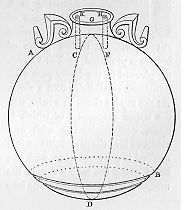BY the same means it is possible to discharge from the same globe both hot and cold water in any quantity. The globe A B (fig. 7) is
 constructed as before, but furnished with a perpendicular partition, C
D, dividing it equally. At the top a tube, H F, soldered into the globe,
communicates with the interior; this tube is also furnished with a
partition, C G, a continuation of the partition C D, and its openings,
H K, must curve over in the directions C and F.
On each side of the partition C D, at the bottom of the globe
towards D, let holes be made like those in a cook's ladle. When it is
desired to draw hot water, take the apertures H and K by the two fingers
and plunge the globe into hot water, and then unclose one of the vents,
H, that the air in the hemisphere B C D may be driven out through H: the
hot water, entering through the holes, will fill the hemisphere B C D
again stopping the vent H take the globe out of the water, and its
contents will be retained, as the air has no entrance. Then, in like
manner, plunge the globe into cold water, unclosing the vent K, and,
when the hemisphere A C D is filled, close K and draw the globe out.
The globe is now full of hot and cold water, and when it is desired to
discharge either of these, unclose the proper vent: in like manner close
it again when the discharge is sufficient; and this may be repeated till
the contents are exhausted. In the same way it is possible to draw up
into and discharge from the same vessel wine, and cold or hot water, and
anything else whatever, at any time, and in any quantity, by making the
necessary partitions and orifices through which the air may enter into
each chamber and leave it again. Instead of the curved outlets, holes
may be made in the upper part of the sides of the tube in various
directions; and these holes are of course to be closed when it is
required to shut out the air. That the holes pierced in the bottom of
the vessel may not be seen, both sets may be included in one channel, so
that both streams may appear to flow from the same source.
constructed as before, but furnished with a perpendicular partition, C
D, dividing it equally. At the top a tube, H F, soldered into the globe,
communicates with the interior; this tube is also furnished with a
partition, C G, a continuation of the partition C D, and its openings,
H K, must curve over in the directions C and F.
On each side of the partition C D, at the bottom of the globe
towards D, let holes be made like those in a cook's ladle. When it is
desired to draw hot water, take the apertures H and K by the two fingers
and plunge the globe into hot water, and then unclose one of the vents,
H, that the air in the hemisphere B C D may be driven out through H: the
hot water, entering through the holes, will fill the hemisphere B C D
again stopping the vent H take the globe out of the water, and its
contents will be retained, as the air has no entrance. Then, in like
manner, plunge the globe into cold water, unclosing the vent K, and,
when the hemisphere A C D is filled, close K and draw the globe out.
The globe is now full of hot and cold water, and when it is desired to
discharge either of these, unclose the proper vent: in like manner close
it again when the discharge is sufficient; and this may be repeated till
the contents are exhausted. In the same way it is possible to draw up
into and discharge from the same vessel wine, and cold or hot water, and
anything else whatever, at any time, and in any quantity, by making the
necessary partitions and orifices through which the air may enter into
each chamber and leave it again. Instead of the curved outlets, holes
may be made in the upper part of the sides of the tube in various
directions; and these holes are of course to be closed when it is
required to shut out the air. That the holes pierced in the bottom of
the vessel may not be seen, both sets may be included in one channel, so
that both streams may appear to flow from the same source.